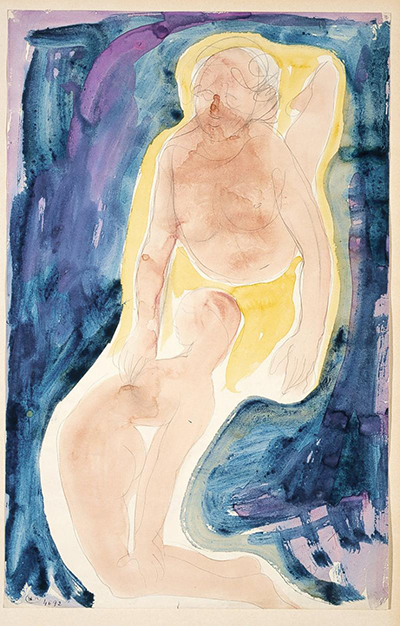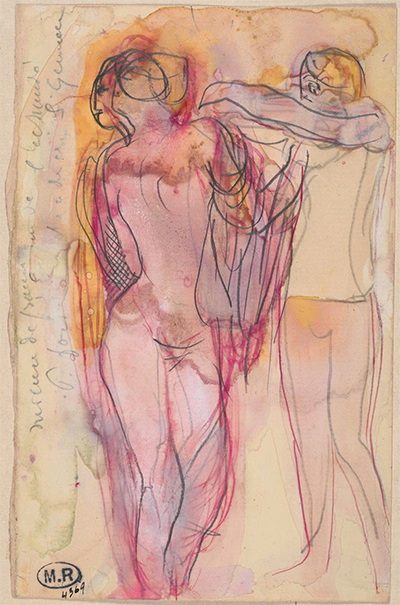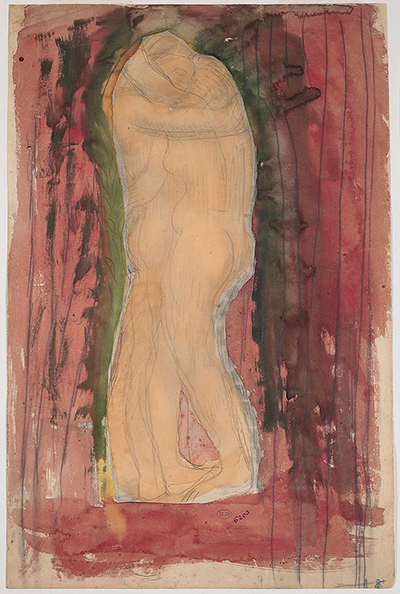Whilst Auguste Rodin was, first and foremost, a sculptor, he also experimented with a number of other mediums and achieved success within many of them. His is not known to have used oils often, if ever, but he did produce a good number of watercolour paintings that often made use of other drawing mediums within them too.
The item shown here is a good example of how he would initially draw using a simple pencil before than adding bright tones of watercolour paint in a fairly expressive manner. Most of his paintings were portraits, in line with his preference for figurative sculpture, but the sudden arrival of a palette gives us an interesting additional insight into the mind of Rodin. His approach to painting is pretty much what you would expect for those who understand his sculpture, both in terms of content and also style. One issue that he would have been aware of was how the sculpture medium allows constant alterations, up to a point, where as watercolour painting is an immediate form of expression that comes and goes in an instant. He would have to have accepted this in order to work effectively with this medium as normally he would tweak his sculptures almost to eternity.
Form was always more important than subject for Rodin, and he would often change the titles of his work many times as he sought to match it with whatever he had created. In the case of his paintings, he would use pencil initially to draw out the figurative lines before adding watercolour and gouache to really express himself. There was no real precision involved once the pencil lines had been finished, as he went deep into his mind and soul in order to extract different choices of colour as well as allowing his brush to add paint freely. One can see this in how many of the blocks of colour would overlap with each other, with other strokes looking quick and unplanned. This contrasted completely with his sculptures that were crafted with care and considerable time as he continued to tweak them for many hours, days, even months.
In the case of most of his figurative paintings, the artist would initially fill his lines of pencil with a brown ochre wash that was subtle but allowed a brightness once the surrounding colours had been added afterwards. Many of these were completed with live models, in just a few minutes. It was an alternative to photography, something that he would also use many times as well, though always in commissioning professional photographers rather than taking any pictures himself. He would also paint directly over photographs as a means to working out new ideas as well as sometimes signalling to his photographers about changed he wanted in the next series of photographs, such as a change in lighting or angle. Many of these amended pictures were discovered within his own collection of some 7,000 prints, which is now owned by the Musee Rodin in Paris. As his career developed he would use all manner of different mediums as a way of expressing his ideas and preparing for upcoming sculptures, which was always his main concern.
One of the elements that watercolours offered Rodin was the opportunity to add movement to his drawings. By loosely brushing colour into his figurative works, one gets a sense of atmosphere and movement, as seen in the likes of this Cambodian Dancer. The blurred lines which occur between the various forms help to recreate the idea of watching dance, where nothing is static at any point. In those cases the artist might only colour the dancers themselves and leave the rest of the composition blank or in a subtle tone of wash. There is, of course, a high level of abstraction within these study drawings, occurring many years before this style achieved a level of success within the academic art world. Sculptures has always been, essentially, abstract, and so we should not be surprised to see a sculptor such as this use a lack of detail within his portrait drawings and paintings. The expressive nature also matched his deep thinking personality and the contemporary nature of all of his work.
In the earlier period of his career, particularly throughout the 1880s, Rodin worked with a dark style in his drawings and rarely used watercolours. He liked to concentrate on inspiration from literature, as shown in his use of Dante's Inferno, for example. Many academics have labelled these as his black drawings, in a similar way to Goya's Black Paintings, because of these colour schemes which expressed negative emotion. He would produce these using dark washes with white gouache heightening and a good use of detail in an intense fashion. This sombre approach was slowly replaced during the late 1880s as he moved towards the brighter tones that you find displayed in this section. Detail would be reduced, and a set of brighter colour combinations would appear for the first time. Purples, blues and yellows were particularly common and to see them contrasting alongside each other provided a powerful experience for the viewer. He now worked more quickly and with a relaxed approach to whatever appeared in each piece. These artworks could be considered disposable in some ways, but he kept and preserved the best ones.
One note of caution around his drawings and watercolours is that a large number of forgeries have been uncovered in recent years, as much as 60% of those currently in private collections, in the view of some. The simplicity of his later style is ideal for this form of mimicing, and only the finest experts would be able to differentiate between the real and the fake. Thankfully, the Musee Rodin has made great strides in documenting all of what they themselves have and this information then helps us to root out any of the illegal copies. Additionally, as interest in Rodin increased, so did the value of his artworks and it became patently obvious that it would be easier to flood the market with forged drawings than to attempt to recreate a genuine Rodin sculpture in a believable way. Due to the large numbers of paintings that he produced it seems unlikely that these question marks will ever be removed completely, and so anyone looking to enter auctions for his work would be advised to do so with caution, and to only use respected sellers and auctioneers. His photographs do not carry quite as much value, in the main, and would also be harder to fool experts with, though again there are around 7,000 already documented from his career, with many more lying around in attics and the like, without question.
Rodin would often explain how he would keep his eyes entirely focused on a model whilst producing drawings, so as not to break the connection that he felt. To work in this way would mean that detail would be hard to achieve, as he was almost giving way to hus sub-conscious mind and allowing that to work for him. He would often then allow himself to refer to the drawing outlines afterwards and make small amendments as necessary, but the original feeling would be protected. It was then that the watercolours would be added with a preference for bright tones which matched his own expressive nature - yellows, pinks, blues and purples worked particularly well in combinations and he would often leave his models in a simple wash that allowed the original drawn lines to show through. The idea around working directly to paper but without initially looking away from the model was in order to capture a specific moment in time, as well as perhaps a movement in some cases. Many portrait draughtsman have approached this medium with a simplicity that took many years to master, and that is the sign of genius in some senses, where they are able to reduce some complex to just a few lines of pencil or brushstrokes.
It could be said that the specific use of watercolours would allow Rodin to start to allow himself to lose control, with an element of chance controlling the direction and behaviour of the tinted water. Having been so obsessive with his sculptures, where amendments could go on for months at a time, he was almost set free with this new art form and allowed to concentrate on expression without the pressure of expectation. There was also the speed at which he would work, meaning none of his watercolours would ever become stale after being considered again and again over a long period. It may have been that the considerations of palettes also offered him something different that revitalised his creative thinking and allowed him a break from his main work. This has proven to be the case for many famous artists over the years who have needed something different from time to time in order to keep their career fresh and innovative, otherwise fatique and disinterest could creep in, especially when forced to produce directed commissions for others.
Something we have discussed elsewhere is how form was more important to Rodin than subject. Whilst his lines of pencil would become covered by tones of watercolour, they would normally still be visible so that the original forms were not lost. He would then name his creations, rather than starting out with the subject in mind in the first place. This was because nature and the human body were his primary concern, rather than whether they accurately symbolised a mythical or religious tale - he would essentially review the artwork and then append a suitable title afterwards. In some cases the name would be suggested to him by a colleague, model or photographer and he also often changed them many times afterwards, particularly his sculptures that would remain in his mind for a long time after being completed. This way of working allowed him to avoid restricting himself with a subject matter and would be a better way of working for those with a more expressive nature. It also has told academics and historians to take most of the titles of his works with a pinch of salt, as they were not generally in his mind during the actual production process.
"...First of all, nature must be captured as it offers itself, then, once the work is finished, its precise meaning can be found, if one so wishes..."
The somewhat uncontrolled nature of watercolour, at least in the way that Rodin worked, meant that he would sometimes allow the water to flow as it wished and then adapt the piece afterwards as new forms appeared. One example involved a clump of colour which to the artist signified a young child or baby, and so Rodin reworked touches of pencil in order to confirm to the viewer what this new item represented. This essentially allowed a randomness to enter his watercolour paintings, something that you would not find with his sculptures. That approach also allowed a uniqueness to fall upon each of these artworks, as if produced from a moment of time that could never be recreated. Another final technique which provides interest to art historians is how he might cut out some of these forms and re-use them elsewhere as cut-outs, way before the likes of Henri Matisse was forced to do the same due to his deteriorating health. It was yet another cross-mediums idea from Rodin who remains a famous sculptor whose skills were much more diverse than most people realise.






